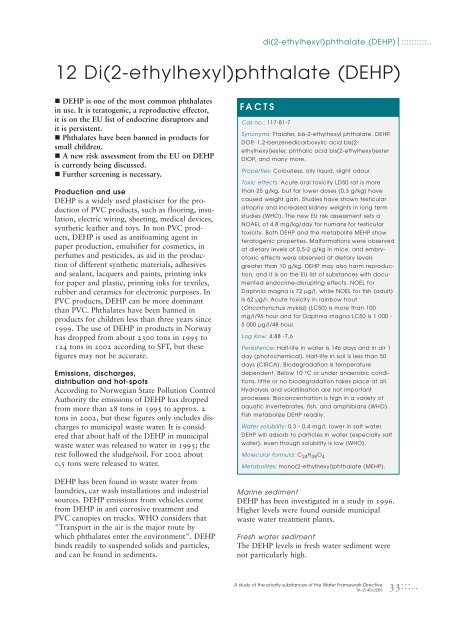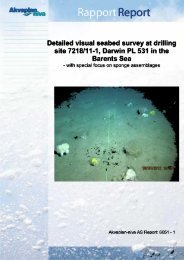A study of the priority substances of the Water Framework Directive ...
A study of the priority substances of the Water Framework Directive ...
A study of the priority substances of the Water Framework Directive ...
You also want an ePaper? Increase the reach of your titles
YUMPU automatically turns print PDFs into web optimized ePapers that Google loves.
� DEHP is one <strong>of</strong> <strong>the</strong> most common phthalates<br />
in use. It is teratogenic, a reproductive effector,<br />
it is on <strong>the</strong> EU list <strong>of</strong> endocrine disruptors and<br />
it is persistent.<br />
� Phthalates have been banned in products for<br />
small children.<br />
� A new risk assessment from <strong>the</strong> EU on DEHP<br />
is currently being discussed.<br />
� Fur<strong>the</strong>r screening is necessary.<br />
Production and use<br />
DEHP is a widely used plasticiser for <strong>the</strong> production<br />
<strong>of</strong> PVC products, such as flooring, insulation,<br />
electric wiring, sheeting, medical devices,<br />
syn<strong>the</strong>tic lea<strong>the</strong>r and toys. In non PVC products,<br />
DEHP is used as antifoaming agent in<br />
paper production, emulsifier for cosmetics, in<br />
perfumes and pesticides, as aid in <strong>the</strong> production<br />
<strong>of</strong> different syn<strong>the</strong>tic materials, adhesives<br />
and sealant, lacquers and paints, printing inks<br />
for paper and plastic, printing inks for textiles,<br />
rubber and ceramics for electronic purposes. In<br />
PVC products, DEHP can be more dominant<br />
than PVC. Phthalates have been banned in<br />
products for children less than three years since<br />
1999. The use <strong>of</strong> DEHP in products in Norway<br />
has dropped from about 2300 tons in 1995 to<br />
124 tons in 2002 according to SFT, but <strong>the</strong>se<br />
figures may not be accurate.<br />
Emissions, discharges,<br />
distribution and hot-spots<br />
According to Norwegian State Pollution Control<br />
Authority <strong>the</strong> emissions <strong>of</strong> DEHP has dropped<br />
from more than 28 tons in 1995 to approx. 2<br />
tons in 2002, but <strong>the</strong>se figures only includes discharges<br />
to municipal waste water. It is considered<br />
that about half <strong>of</strong> <strong>the</strong> DEHP in municipal<br />
waste water was released to water in 1995; <strong>the</strong><br />
rest followed <strong>the</strong> sludge/soil. For 2002 about<br />
0,5 tons were released to water.<br />
DEHP has been found in waste water from<br />
laundries, car wash installations and industrial<br />
sources. DEHP emissions from vehicles come<br />
from DEHP in anti corrosive treatment and<br />
PVC canopies on trucks. WHO considers that<br />
"Transport in <strong>the</strong> air is <strong>the</strong> major route by<br />
which phthalates enter <strong>the</strong> environment". DEHP<br />
binds readily to suspended solids and particles,<br />
and can be found in sediments.<br />
FACTS<br />
di(2-ethylhexyl)phthalate (DEHP) ::::::::::..<br />
12 Di(2-ethylhexyl)phthalate (DEHP)<br />
Cas no.: 117-81-7<br />
Synonyms: Ftalater, bis-2-ethylhexyl phthalate, DEHP,<br />
DOP, 1,2-benzenedicarboxylic acid bis(2ethylhexyl)ester,<br />
phthalic acid bis(2-ethylhexyl)ester<br />
DIOP, and many more.<br />
Properties: Colourless, oily liquid, slight odour.<br />
Toxic effects: Acute oral toxicity LD50 rat is more<br />
than 25 g/kg, but far lower doses (0,3 g/kg) have<br />
caused weight gain. Studies have shown testicular<br />
atrophy and increased kidney weights in long term<br />
studies (WHO). The new EU risk assessment sets a<br />
NOAEL <strong>of</strong> 4,8 mg/kg/day for humans for testicular<br />
toxicity. Both DEHP and <strong>the</strong> metabolite MEHP show<br />
teratogenic properties. Malformations were observed<br />
at dietary levels <strong>of</strong> 0,5-2 g/kg in mice, and embryotoxic<br />
effects were observed at dietary levels<br />
greater than 10 g/kg. DEHP may also harm reproduction,<br />
and it is on <strong>the</strong> EU list <strong>of</strong> <strong>substances</strong> with documented<br />
endocrine-disrupting effects. NOEL for<br />
Daphnia magna is 72 µg/l, while NOEL for fish (adult)<br />
is 62 µg/l. Acute toxicity in rainbow trout<br />
(Oncorhynchus mykiss) (LC50) is more than 100<br />
mg/l/96 hour and for Daphnia magna LC50 is 1 000 -<br />
5 000 µg/l/48 hour.<br />
Log Kow: 4,88 -7,6<br />
Persistence: Half-life in water is 146 days and in air 1<br />
day (photochemical). Half-life in soil is less than 50<br />
days (CIRCA). Biodegradation is temperature<br />
dependent. Below 10 °C or under anaerobic conditions,<br />
little or no biodegradation takes place at all.<br />
Hydrolysis and volatilisation are not important<br />
processes. Bioconcentration is high in a variety <strong>of</strong><br />
aquatic invertebrates, fish, and amphibians (WHO).<br />
Fish metabolize DEHP readily.<br />
<strong>Water</strong> solubility: 0,3 - 0,4 mg/l, lower in salt water.<br />
DEHP will adsorb to particles in water (especially salt<br />
water), even though solubility is low (WHO).<br />
Molecular formula: C 24 H 38 O 4<br />
Metabolites: mono(2-ethylhexyl)phthalate (MEHP).<br />
Marine sediment<br />
DEHP has been investigated in a <strong>study</strong> in 1996.<br />
Higher levels were found outside municipal<br />
waste water treatment plants.<br />
Fresh water sediment<br />
The DEHP levels in fresh water sediment were<br />
not particularly high.<br />
A <strong>study</strong> <strong>of</strong> <strong>the</strong> <strong>priority</strong> <strong>substances</strong> <strong>of</strong> <strong>the</strong> <strong>Water</strong> <strong>Framework</strong> <strong>Directive</strong><br />
TA-2140/2005<br />
33:::..

















